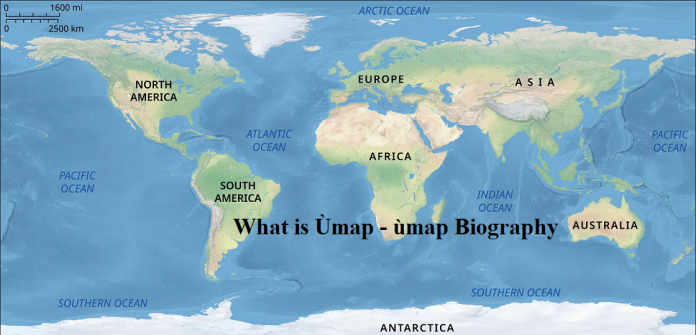ùmap, or Uniform Manifold Approximation and Projection, is a powerful and versatile technique for dimensionality reduction and data visualization. It emphasizes the relationships between elements in space, either perceived or actual, and reflects the choices, biases, and agendas of the mapmaker. Maps can present information about the world in a simple, visual way, and they can be used for various purposes, such as navigation, education, and decision-making. While most commonly used to depict geography, maps may represent any space, real or fictional, without regard to context or scale. UMAP refers to Uniform Manifold Approximation and Projection, which is an algorithm for dimension reduction based on manifold learning techniques and ideas from topological data analysis. It is used for data visualization and can be applied to various fields such as biology, computer science, and social sciences.
Features of ùmap
The term “UMAP” stands for “Uniform Manifold Approximation and Projection.” It is an algorithm for dimension reduction based on manifold learning techniques and ideas from topological data analysis. UMAP is used for data visualization and can be applied to various fields such as biology, computer science, and social sciences. UMAP provides a very general framework for approaching manifold learning and dimension reduction, and it can also provide specific concrete realizations.
Some Applications of ùmap
These applications demonstrate the versatility of UMAP in handling complex high-dimensional data for visualization and analysis purposes. UMAP, or Uniform Manifold Approximation and Projection, has various applications, including:
-
- Dimensionality Reduction and Visualization
UMAP is commonly used for projecting high-dimensional data into a lower-dimensional space for visualization and exploration purposes.
- Embedding to Non-Euclidean Spaces
It can be applied to embed data into non-Euclidean spaces, which is useful in various fields such as biology, computer science, and social sciences.
- Plane Embeddings
UMAP can be used for plane embeddings, which is a technique to represent data in a two-dimensional plane while preserving the underlying structure of the high-dimensional data.
- Dimensionality Reduction and Visualization
Why ùmap is Important
UMAP is important for its ability to effectively handle high-dimensional data, capture non-linear relationships, and aid in feature interpretation, making it a valuable tool in various domains such as data analysis, machine learning, and visualization. Unlike traditional linear dimensionality reduction techniques, UMAP excels at capturing non-linear structures in the data, making it valuable for tasks where the data has complex relationships and patterns. UMAP can help in identifying important features in the data. It can reveal which features are most relevant for the final dimensionality reduction, which is valuable for understanding the underlying structure of the data and making informed decisions about feature selection.
Limitations of ùmap
It’s important to be aware of these limitations and to use other methods to validate and explain findings when using UMAP for data visualization and dimensionality reduction. The limitations of UMAP (Uniform Manifold Approximation and Projection) include:
-
- Sensitivity to Data Quality
UMAP is sensitive to the quality and distribution of the data. It may produce misleading or distorted results if the data is noisy, sparse, or contains outliers. For example, noise can create artificial clusters or bridges between clusters, and outliers can pull points away from their true neighbors.
- Parameter Sensitivity
The algorithm’s performance can be influenced by the choice of parameters, such as “n_neighbors” and “min_dist,” which affect the trade-off between preserving local and global structure, as well as the speed and stability of the algorithm. Choosing the right parameters is crucial for obtaining meaningful results.
- Uncertainty and Stochasticity
UMAP space is not Euclidean, and there can be uncertainties in the coordinates of data points. Without a visual representation of uncertainty, it can be easy to overlook the stochastic nature of the results.
- Sensitivity to Data Quality
Importance of ùmap
It is particularly useful for exploring and understanding complex and high-dimensional data sets, such as images, text, or genomic data. ùmap is important for its ability to effectively handle high-dimensional data, capture non-linear relationships, and aid in feature interpretation, making it a valuable tool in various domains such as data analysis, machine learning, and visualization.
-
- Capture Non-linear Structures
Unlike traditional linear dimensionality reduction techniques, ùmap excels at capturing non-linear structures in the data, making it valuable for tasks where the data has complex relationships and patterns.
- Handle High-Dimensional Data
ùmap is effective at handling high-dimensional data, which can be difficult to visualize and analyze using traditional methods. It can help in visualizing and exploring complex datasets in a lower-dimensional space, making it easier to understand and interpret the data.
- Identify Important Features
ùmap can help in identifying important features in the data. It can reveal which features are most relevant for the final dimensionality reduction, which is valuable for understanding the underlying structure of the data and making informed decisions about feature selection.
- Capture Non-linear Structures
Provide a General Framework
ùmap provides a very general framework for approaching manifold learning and dimension reduction, and it can also provide specific concrete realizations.






